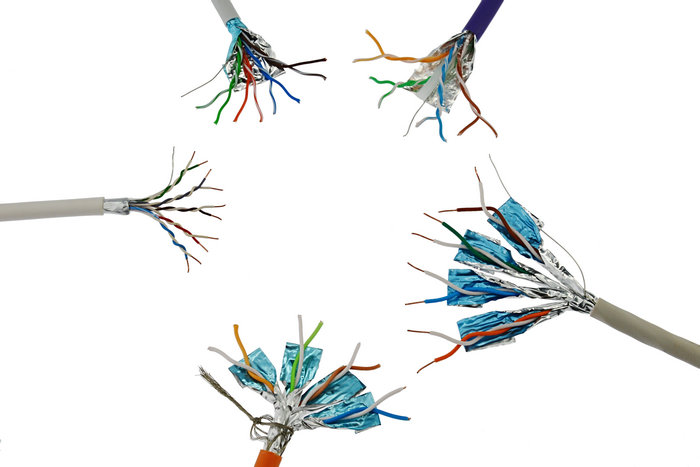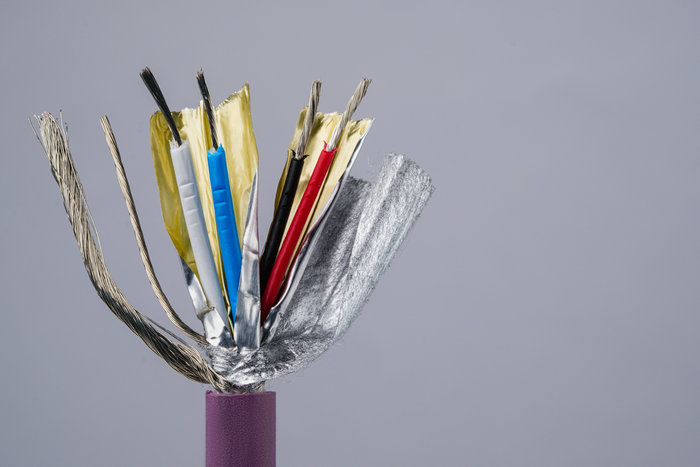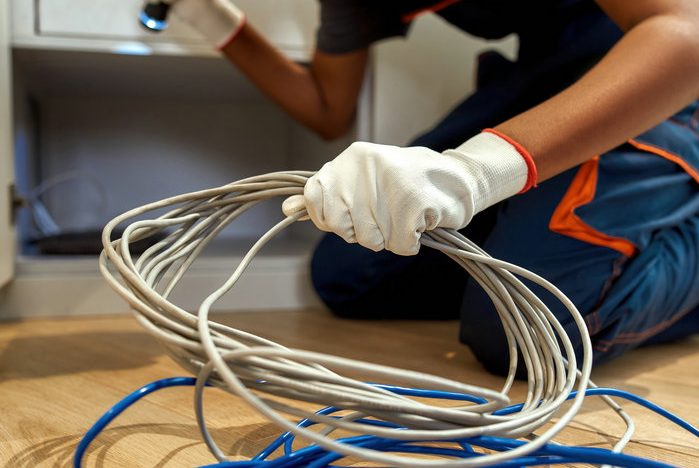Ethernet cables are an essential component of your network infrastructure, responsible for transmitting data between your computer and devices. In this article, you’ll learn about the differences between shielded and unshielded cables and what to consider when choosing the right cable for your needs.

Understanding Ethernet Cables
Network cable like Ethernet cables, come in various categories. These categories, denoted as “Cat,” represent different performance levels. Common choices include Cat5e, Cat6, Cat6a and Cat8 ethernet cables.
Ethernet cables are often made up of twisted pairs, which are pairs of wires twisted together to reduce electromagnetic interference (EMI). These twisted pairs help improve the signal quality and reliability of your network connections.
Ethernet Cable Shielded vs Unshielded

There are two primary types of twisted pair Ethernet cables: shielded and unshielded. Shielded cables offer more robust protection against EMI, while unshielded cables provide faster transmission speeds in the absence of EMI.
- Shielded Ethernet cables are more expensive and difficult to install than their unshielded counterparts due to their stiffness and larger diameter. They are ideal for environments where there are many potential sources of interference, such as industrial or high wireless traffic areas.
- Unshielded Ethernet cables consist of four pairs of twisted wires and are more cost-effective and easier to install, making them suitable for small homes or businesses where EMI is not a significant concern.
What is Shielded Ethernet Cable
A shielded Ethernet cable, also known as shielded twisted pair (STP) cable, provides an extra layer of protection against electromagnetic interference (EMI) compared to their unshielded counterparts. The shielding is typically made of a metal mesh or foil, which wraps around the twisted pairs of wires inside the cable. This helps reduce the impact of EMI on your network performance and ensures a more stable and reliable connection.
When using shielded cables, you’ll notice that they are more rigid and a bit thicker than unshielded cables. This is due to the additional shielding material. However, when installing shielded cable, one can inadvertently create issues if it’s not properly grounded. This is necessary as unwanted external interference is directed down this shield, including the ESD or drain wire, toward the ground.
Types of Shielded Ethernet Cables
There are various types of shielded Ethernet cables, and each one offers a different level of protection:
- STP (Shielded Twisted Pair): This type of cable is shielded at the overall cable level. There is a single, complete shield surrounding all the twisted pairs inside the cable. STP cables are commonly used in Cat5e and Cat6 ethernet cables. For STP Ethernet cables to block EMI effectively, the shielding layer must be grounded. STP cables include a drain wire for this, but the grounding continuity relies on compatible shielded components. Even high-quality STP cable loses its shielding benefits if unshielded jacks or couplers break the ground path.
- S/STP (Screened/Shielded Twisted Pair): In this type of cable, each twisted pair has its own individual shield, and there is also an overall shield surrounding all the pairs. This design provides maximum protection against EMI. S/STP cables are often found as part of high-performance Cat6a ethernet cabling.
- S/FTP (Screened/Foiled Twisted Pair): Similar to S/STP, each twisted pair in this cable type has its own individual foil shield, and all the pairs are surrounded by an overall shield. S/FTP cables also offer excellent EMI protection, making them suitable for high-performance applications like Cat-6 and Cat-6a networks.
Choosing the right type of shielded Ethernet cable depends on your specific needs and the level of EMI in your environment. In general, if you’re dealing with higher levels of EMI, S/STP and S/FTP cables will provide the best protection. However, if your environment has a moderate level of EMI, STP cables may suffice.
What is Unshielded Ethernet Cable

Unshielded Ethernet cables, also known as Unshielded Twisted Pair (UTP) cables, are a type of Ethernet cable without additional shielding around the wire pairs. These cables offer the same bandwidth, cable lengths, and outputs as shielded cables. These cables are designed such that the pairs are twisted inside the cables in order to mitigate EMI. They are a popular choice for connecting devices in small home or office setups because of their cost-effectiveness and ease of installation.
When you think of UTP cables, you might picture the commonly used Cat5e cable. This is an unshielded Ethernet cable capable of delivering speeds up to 1000 Mbps or 1 Gbps, and it is widely used for home and small office networking.
Types of Unshielded Ethernet Cables
There are several types of unshielded Ethernet cables available, including:
- Cat5: This older generation cable supports speeds up to 100 Mbps and can be used for basic networking needs. However, it’s worth considering upgrading to Cat5e for better performance.
- Cat5e: A popular choice, the Cat5e Ethernet cable is an enhanced version of the Cat5 cable. It supports speeds up to 1 Gbps and offers improved crosstalk performance over Cat5.
Although unshielded Ethernet cables are more susceptible to EMI compared to their shielded counterparts, they can still perform reliably in most home and small office environments. When choosing a cable for your network, consider factors like the distance between devices, potential sources of interference, and your desired network speed.
Shielded and Unshielded Cables in Various Industries
Noisy industrial settings like airports, medical facilities, and factories commonly require STP cabling. These locations house many machines that generate significant EMI, which could degrade signal quality over long or numerous UTP runs. STP’s protective foil or braided shielding helps maintain strong, clear communications in high-interference conditions.
Residential and typical office spaces, which feature fewer heavy-duty electronics or medical equipment, generally have lower EMI levels. As such, cost-effective UTP cables often meet connectivity demands without issues. Their simpler design provides Gigabit networking performance for standard business and home office tasks.
In this section, we will discuss the use of shielded and unshielded Ethernet cables in various industries, focusing on data centers and industrial machinery. You will learn about the benefits and potential challenges associated with each type of cabling in different environments.
Cabling in Data Centers
Data centers require stable, fast, and reliable connections to operate efficiently. In such environments, you may encounter various sources of electromagnetic interference (EMI), including generators, air conditioners, and fluorescent lights. This interference can significantly impact the performance of your Ethernet cables.
In most cases, data centers utilize shielded twisted pair (STP) cables. The shielding in STP cables helps reduce near-end crosstalk (NEXT) and protect the cables from EMI. Unshielded twisted pair (UTP) cables are also used, but they lack the additional shielding that provides protection against EMI.
Industrial and Machinery Use of Ethernet Cables
Industrial environments and machinery often require Ethernet cables to withstand even more robust conditions. These settings typically involve motors, power lines, generators, and other equipment that can generate strong EMI.
In these settings, you would typically rely on shielded Ethernet cables due to their ability to protect against EMI. The International Electrotechnical Commission (IEC) and the Institute of Electrical and Electronics Engineers (IEEE) have developed standards for Ethernet cables specifically designed for industrial settings. These standards ensure that the cables perform optimally even in the presence of strong EMI sources.
When selecting the appropriate Ethernet cable for your industrial or machinery environment, be aware of the specific challenges and requirements your network faces. Shielded Ethernet cables can provide the protection and performance needed to maintain a stable connection in these demanding conditions, while unshielded cables might not be sufficient.
Frequently Asked Questions
When should unshielded Ethernet cables be used?
Unshielded twisted pair (UTP) Ethernet cables are typically sufficient for small homes or businesses where electromagnetic interference (EMI) is less of a concern. The twisting of the wire pairs helps to reduce EMI, making UTP cables suitable for most everyday applications. However, if your environment has a high level of EMI or radio frequency interference (RFI), you may need to consider using shielded cables instead.
Does using shielded cables improve PoE performance?
Shielded Ethernet cables can offer some benefits when using Power over Ethernet (PoE). The shielding helps to reduce electromagnetic interference (EMI), which can degrade PoE performance by causing voltage drops and other issues. Although shielding is not crucial for PoE performance, it may help maintain consistent power delivery, especially in environments with high EMI or RFI.
Are shielded cables necessary for outdoor installations?
Shielded cables are usually recommended for outdoor installations or in areas exposed to harsh environmental conditions. This is because outdoor environments often have higher levels of EMI or RFI, which can affect the performance of unshielded cables. Moreover, shielded cables typically have a more robust jacket construction, providing extra protection against physical damage and various weather elements.
How does grounding affect shielded Ethernet cables?
Proper grounding is essential when using shielded Ethernet cables. The shielding acts as a barrier against EMI, but it needs to be grounded to function correctly. Grounding the shielding ensures that any interference picked up by the shield is safely directed to the ground, preventing it from affecting the data transmission within the cable. Running shielded cables without proper grounding can result in reduced performance or even completely negate the benefits of using shielded cables.v
